 MY
TRAIN TRAVELS IN ASIA-PACIFIC REGION
MY
TRAIN TRAVELS IN ASIA-PACIFIC REGION
Fiji, Australia, and China
This
page covers the Fiji sugar cane train, the Kuranda Railway in
Queensland Australia, a 1974 train trip from Hong Kong to Shanghai en
route to Beijing, and trains, subways, streetcars, buses, ferries,
hydrofoils, a cable tram,
and cableways on a vacation in Hong Kong in 2009. Variety is
definitely the spice on my Dish of Life.
 Coral Coast Railway --
Fiji's Sugar Cane Tourist
Train -1993
Coral Coast Railway --
Fiji's Sugar Cane Tourist
Train -1993
 The
island country of Fiji in the South Pacific Ocean creates memories of tropical Paradise that
last a lifetime. In addition, Fiji has trains - not many and not
fancy, but easily found by tourists. One is shown here from a
vacation in 1993. The Sugar
Cane Train operated by Coral Coast Railway runs from Sigatoka up to Natadola Beach. Nearest airport is Nadi, Fiji,
about an hour north of Sigatoka.
The
island country of Fiji in the South Pacific Ocean creates memories of tropical Paradise that
last a lifetime. In addition, Fiji has trains - not many and not
fancy, but easily found by tourists. One is shown here from a
vacation in 1993. The Sugar
Cane Train operated by Coral Coast Railway runs from Sigatoka up to Natadola Beach. Nearest airport is Nadi, Fiji,
about an hour north of Sigatoka.
A very pink steam loco converted to diesel, with open-air
excursion-style passenger cars, hauled us the 10 miles from the
depot near the Shangri-La Hotel
to Natadola Beach. Tracks are two-foot gauge (610
mm) hidden in the grass. A picnic BBQ buffet was laid out in the
trees for lunch - very peaceful. Bring your own bottled water,
as parasites abound and they are mean! There was no tourist
development at the beach in 1993, but one hotel is now complete
and a second is in progress.
Real sugar cane cars were hidden in the bushes and under
sheds, but no one was using them that week. The sugar cane
lines cover 375 miles (600 km) of
industrial rails - the largest garden railway in the world.
Today, 25 years after my trip, the train is more run-down and more
of a tourist trap. Don't be guilted into buying candy for the kids
-- it's not good for them and they should be in school anyway. Ditto
souvenirs in the village shops.
On another day, be sure to visit a Fijian village with a Fijian guide. The cultural
contrasts are worth the side trip. The villages you see from
the train are too close to tourists to represent Fijian village
life accurately.

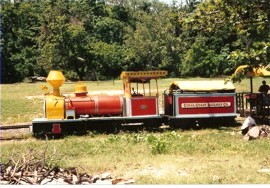
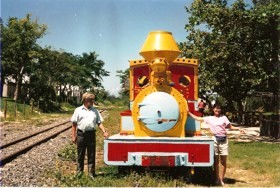
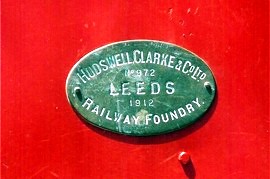
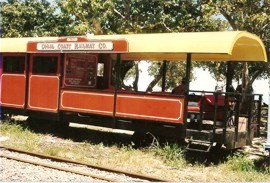
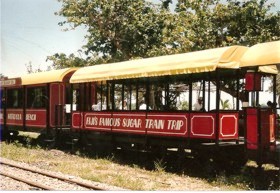
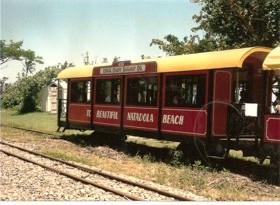
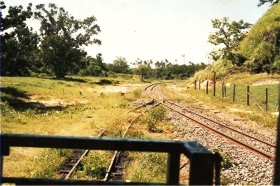
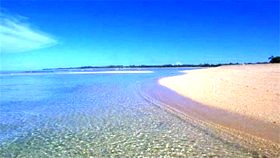
All above
photos taken in 1993 by the author
A real diesel, and still pink. This photo circa 2014, from the TripAdvisor website.
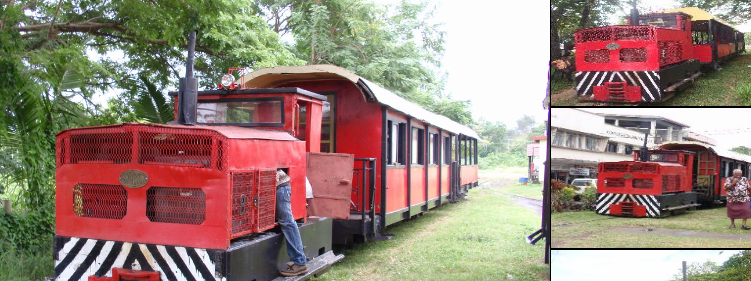
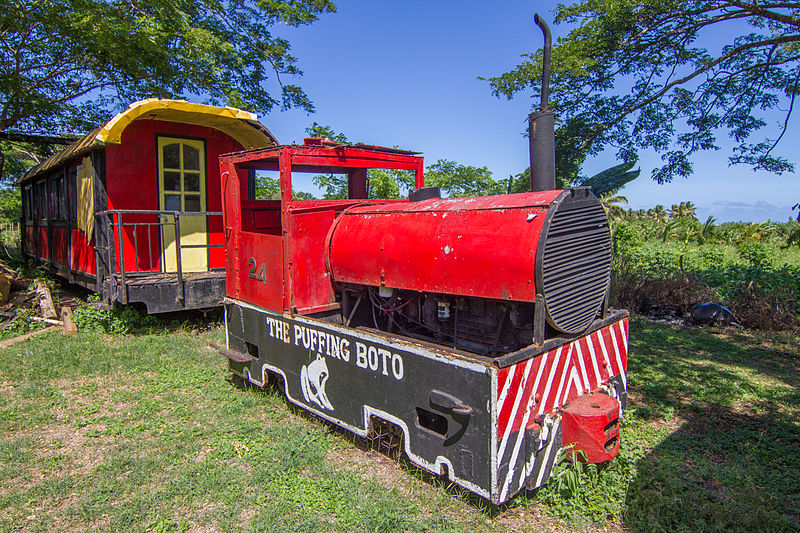
Another view, from Wikipedia
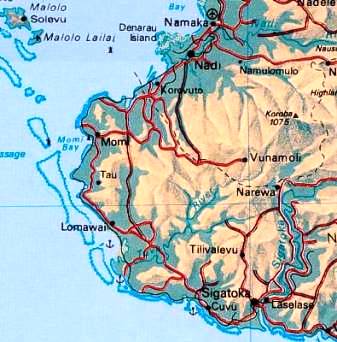 Coral Coast Railway
Coral Coast Railway
Tel: 011.679.652.8731
Fax: 011.679.652.0434
No direct website - see nice review at
http://www.railserve.com/jump/jump.cgi?ID=15422
 Kuranda Scenic Railway
- 1993
Kuranda Scenic Railway
- 1993
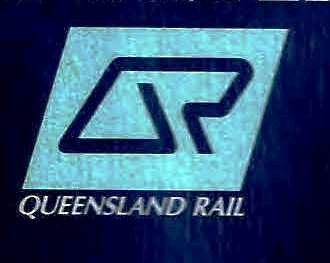 Australia hosts many narrow gauge tourist trains, as
well as some mainlines that were never converted to standard
gauge. At one time there were thousands of miles of 42" gauge
railways in Australia. One of these is shown here from a
vacation in 1993.
The Kuranda Scenic Railway runs from
Cairns (Queensland) north to Kuranda and return, about 34 kilometers
each way. Tracks are three-foot six-inch gauge on immaculate
mainline right-of-way.
Australia hosts many narrow gauge tourist trains, as
well as some mainlines that were never converted to standard
gauge. At one time there were thousands of miles of 42" gauge
railways in Australia. One of these is shown here from a
vacation in 1993.
The Kuranda Scenic Railway runs from
Cairns (Queensland) north to Kuranda and return, about 34 kilometers
each way. Tracks are three-foot six-inch gauge on immaculate
mainline right-of-way.
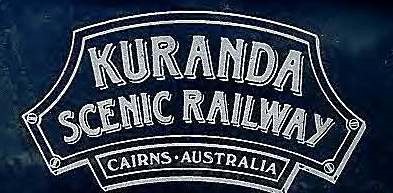
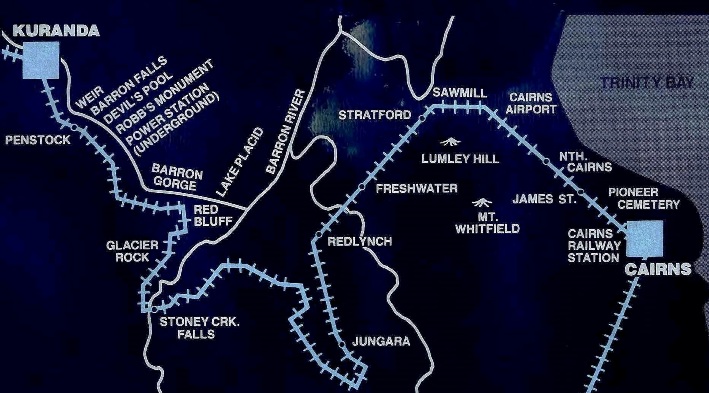
 The
line was begun in 1882 by Christie Palmerston and completed in June
1891, to serve miners in the area. Dense jungle and cliffs with
sheer drops of up to 327 metres and a slope as steep as 45 degrees
were literal death traps for workers. Without modern equipment but
simply fortitude, dynamite, and bare hands the team eventually
finished the job, after removing 2.3 million cubic meters of
earthwork, creating 15 tunnels, 93 curves, dozens of bridges, and 75
kilometres of track.
The
line was begun in 1882 by Christie Palmerston and completed in June
1891, to serve miners in the area. Dense jungle and cliffs with
sheer drops of up to 327 metres and a slope as steep as 45 degrees
were literal death traps for workers. Without modern equipment but
simply fortitude, dynamite, and bare hands the team eventually
finished the job, after removing 2.3 million cubic meters of
earthwork, creating 15 tunnels, 93 curves, dozens of bridges, and 75
kilometres of track.
Purple and cream coaches pulled by diesel power carry a
large audience over the spectacular eastern coastline of
northern Queensland. Numerous spindly bridges, short tunnels,
water falls, and tropical rain forest keep the camera clicking.
There is now a cable car, known as the Kuranda Skyrail, to view
the rain forest from above, not present in 1993 during my visit.
Locomotives are more modern today and carriages boast LCD
television screens pointing out the scenic wonders visible from
the windows. A short side trip to the aboriginal theater and art
gallery at Kuranda are must-see cultural attractions.
Photos by the author taken in 1993, except as noted.
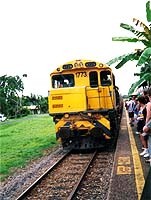
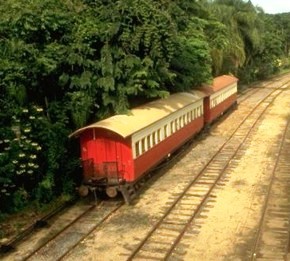
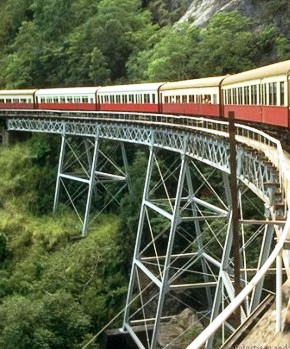
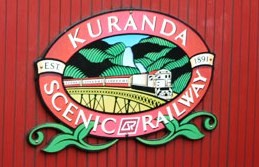
Above: My photos
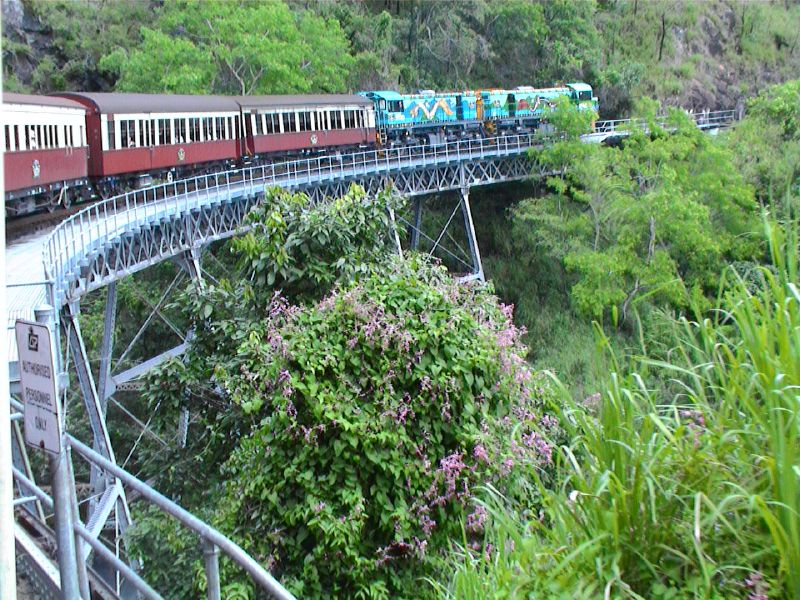
Kuranda Scenic Railway bridge over Barron Falls. Locomotive here is
bright white GE 6-axle unit with only 10 tons per axle so it is pretty gentle on the trackwork. Photo from
Wikipedia.
Below: Images from postcards and KSR brochure
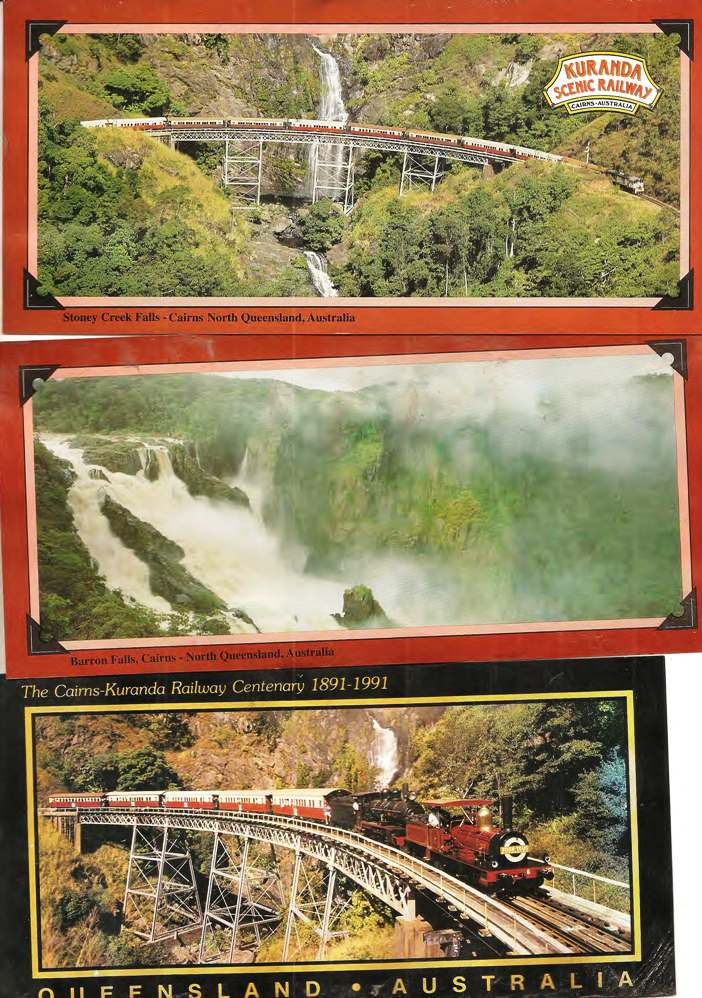
Postcards -- Stoney Creek Falls with diesel train (top), Barron Falls
(middle), Stoney Creek again with steam locomotive on the point
(bottom)
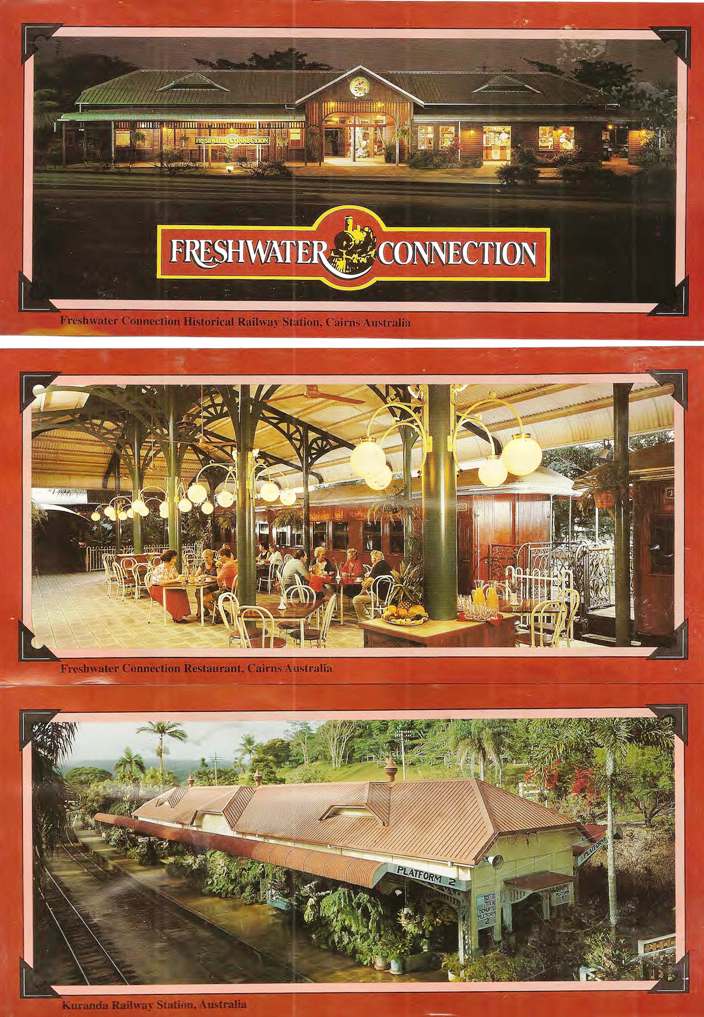
Freshwater Connection Station (top), Freshwater Restaurant (middle),
and Kuranda Station (bottom)

Souvenir Ticket and Boarding Pass
 Hong Kong
To Shanghai - 1974
Hong Kong
To Shanghai - 1974


 I visited Hong Kong
twice, first in January and February 1974 on a business trip, then 35 years later
in January 2009 on a family vacation. Photos are from the 2009 trip, historical
photos are from websites
as noted.
I visited Hong Kong
twice, first in January and February 1974 on a business trip, then 35 years later
in January 2009 on a family vacation. Photos are from the 2009 trip, historical
photos are from websites
as noted.
 Kowloon Canton Railway (KCR) - 1974
Kowloon Canton Railway (KCR) - 1974
In
1974, I was en-route to Beijing with four colleagues for a six week technical sales
presentation. This was a year after US President Nixon "opened
China to the West". The British, Germans, and French were there
before him of course, but who's keeping track?
We had three
days in-bound, waiting on paperwork, to tour Hong Kong
streetcars, the Victoria Peak Tram, Kowloon Ferries, and the
harbour just west of the Peninsula Hotel.
Out-bound, I enjoyed Chinese New Year with a total of
$10 cash in my pocket - the banks were closed and bank machines
didn't exist. Even the black market currency exchanges were
closed, so I walked a lot. The Colony was British and the buses,
trucks, and cars were mostly 1950's and 60's British Leyland.
The Empire had not yet been dispersed.
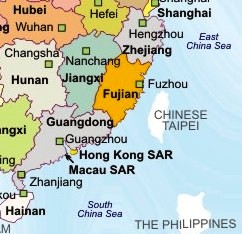
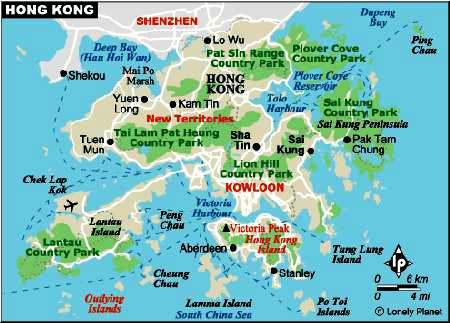
Orientation Maps
of Hong Kong Special Administrative Region
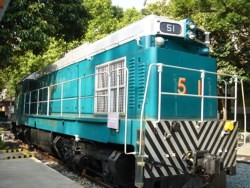 The 1974 train trip from Kowloon to Canton (now Guangzhou) ran
22
miles north to the Chinese border at Lo Wu. Here we walked across a bridge,
through customs, to catch the steam driven express for the
remaining 89 miles to Canton, followed by the longer trip to Shanghai.
The 1974 train trip from Kowloon to Canton (now Guangzhou) ran
22
miles north to the Chinese border at Lo Wu. Here we walked across a bridge,
through customs, to catch the steam driven express for the
remaining 89 miles to Canton, followed by the longer trip to Shanghai.
Known as the Kowloon Canton Railway (KCR), the British section
was completed during 1906 - 1910, with through traffic over the
Chinese section beginning in 1911.
The KCR train was hauled by n GE-EMD G-12 or G-16 Diesel
locomotive. They had 6
wheel trucks to keep the load on the light rails to a minimum.
The G-12's had 1250 hp, arrived in 1954 - 56, and were numbered
51 - 55 (built under license in Australia). The G-16's with
1650 hp were #56 - 59 and arrived in 1960 - 64 (3 built in
Illinois and the last one in Australia). G-12 #51 is preserved
at the Hong Kong Railway Museum at Tai Po. G-16's #56 - 59 were
still running in early 2008 with the KCR logo, usually switching
or hauling mail cars to the International Mail Center as
"extras". They appear to have been retired in 2008 - we did not
see them on our 2009 trip.
Antique
GE-EMD G-16's still in use in 2008, photos from
www.railpictures.net.

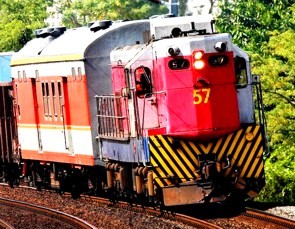
KCR #56 "I. B. Trevor" KCR #57 "Bobby Howes"
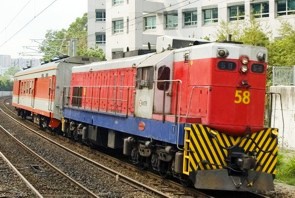
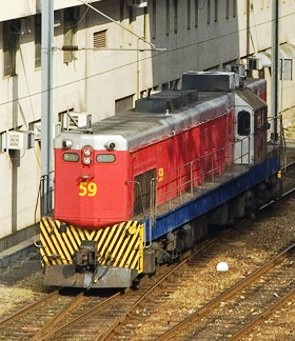
KCR #58 "Gordon Graham" KCR #59 "Gerry Forgates"
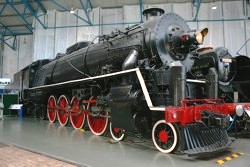 In
1974, there were official "minders" at every transfer point to
see that we found the correct train and did not stray into
sensitive areas. We were the only North Americans on the train,
the balance were Chinese officials, plus British, German, and
French businessmen. Miles of rice paddies, water buffalo,
farmers up to their knees in water, small villages, and many
bridges whizzed past as we rumbled along to Shanghai. We were
not allowed to take pictures from the train. The steam
locomotive at right is similar to the one that hauled us from
Canton to Shanghai.
In
1974, there were official "minders" at every transfer point to
see that we found the correct train and did not stray into
sensitive areas. We were the only North Americans on the train,
the balance were Chinese officials, plus British, German, and
French businessmen. Miles of rice paddies, water buffalo,
farmers up to their knees in water, small villages, and many
bridges whizzed past as we rumbled along to Shanghai. We were
not allowed to take pictures from the train. The steam
locomotive at right is similar to the one that hauled us from
Canton to Shanghai.
We were guided to our hotel, slept in cool stone-walled rooms,
and toured downtown Shanghai on foot. The Sun Yat Sen central
park was the focal point of numerous ornate buildings, nothing
more than 3 or 4 stories high.
After another night at the ancient hotel, we waited two
more days at the Shanghai airport for the 6-engine
Russian equivalent of a DC-8 to fly us to Beijing. Canvas seats
on aluminum frames sized for smaller bodies were extremely
uncomfortable, and the noise from six engines was phenomenal. By
then we started to feel the cold. Beijing has about the same
climate as Winnipeg, and Shanghai's is similar to Vancouver.
Interlude: 35 years later
Now it's 2009, and everything is new, really NEW, except the
Hong Kong streetcars, the Peak Tram, and the Kowloon Ferries.
Well, they don't look new, but all have been rebuilt or replaced
since 1974 and are merely replicas of their former selves. New
buildings, new buses, new underground metro transit, new
airport, new everything. The old is still there, tucked away
between skyscrapers or on steep hillsides.
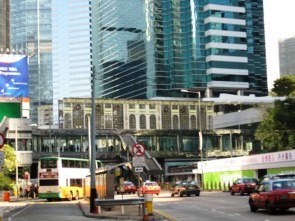
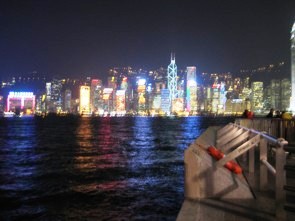
Old and new in
downtown Kowloon
Mostly new in downtown Hong Kong
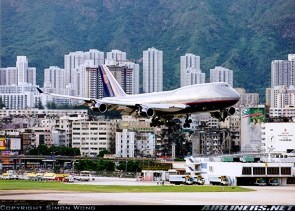 Aside from the 1974 and 2009 trips into Hong Kong, I passed
through the old Kai Tak airport on at least 5 other trips before
it was closed in 1998, en route to Bangladesh or Indonesia.
Aside from the 1974 and 2009 trips into Hong Kong, I passed
through the old Kai Tak airport on at least 5 other trips before
it was closed in 1998, en route to Bangladesh or Indonesia.
Kai Tak Airport c.1974 
Kai Tak was notorious for its difficult approach and landing
procedure while skirting the mountains and high rise buildings
that had sprung up around the airport. It involved a descent to
about 650 feet, (facing into a 1400 ft hill), then a 47 degree
right turn that also dropped the plane to about 140 feet,
hopefully leaving the plane lined up with the runway. Before
1975, this was done visually, later aided by ILS, but the eyes
were still better.
Canadian Pacific Airlines always asked us to lower the window
shades so we
wouldn't see how close to the
buildings we
were; Cathay Pacific just let us gasp in awe.
Hong
Kong Info
Large
Scale Kowloon Map
 Kowloon Canton Railway (KCR) - 2009
Kowloon Canton Railway (KCR) - 2009
 In
the early days of course, KCR was steam powered; diesels arrived
in 1954 and electric multiple unit (EMU) commuter cars arrived
in the 1980's. The
KCR was merged with the MTR, Hong Kong's mass transit system, in
December 2007, after nearly 100 years of independent
operation. The route towards Guangzhou (Canton) became the MTR East Line.
KCR West Rail, a light rail commuter line, became MTR West Line.
In
the early days of course, KCR was steam powered; diesels arrived
in 1954 and electric multiple unit (EMU) commuter cars arrived
in the 1980's. The
KCR was merged with the MTR, Hong Kong's mass transit system, in
December 2007, after nearly 100 years of independent
operation. The route towards Guangzhou (Canton) became the MTR East Line.
KCR West Rail, a light rail commuter line, became MTR West Line.
 The inter-city trains to
Guangzhou and beyond use the same track as the East Line, running diesel powered
express trains, including some high speed bi-level tilt cars, as
well as a "bullet" train. There are at least 10 such trains per
day between Kowloon and Guangzhou.
The inter-city trains to
Guangzhou and beyond use the same track as the East Line, running diesel powered
express trains, including some high speed bi-level tilt cars, as
well as a "bullet" train. There are at least 10 such trains per
day between Kowloon and Guangzhou.
Our hotel room at the Stanford overlooked this
set of tracks
just south of East Mong Kok Station. We
could see and hear the electrics swish past quietly, as well as the
burbling exhaust of the inter-city diesel starting out with 10 or 12 cars.
We also saw a "bullet train" and some bi-level tilt cars, but
were not quick enough with the camera. Ask for a
room number ending in a "2" if you want to train-watch from your
bedroom.
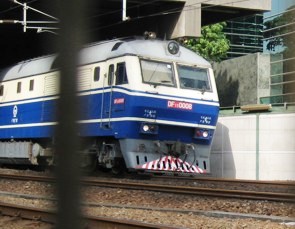
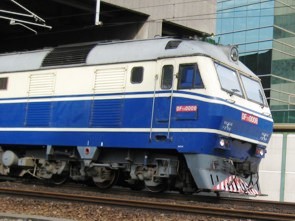
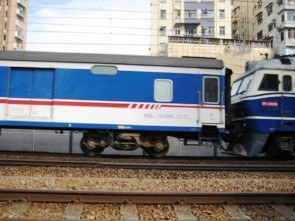
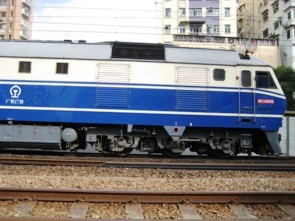
DF-0008 leaving East Mong Kok Station, taken through the safety
screen on the exit platform.
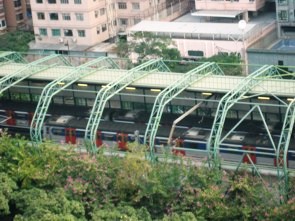

Telephoto shots of
trains south of East Mong Kok Station, from Stanford Hotel room
1602.
The Stanford is on Soy Street halfway between Yau Ma
Tei and Mong Kok Stations, the heart of the Golden Mile shopping
and restaurant district. Reasonable prices too, but food is
usually cold in the hotel restaurant. It's more fun out on
Nathan Road anyway, with every ethnic cuisine you can imagine,
including McD.
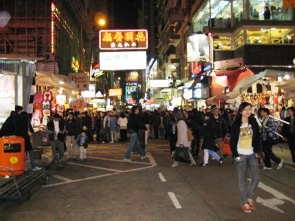
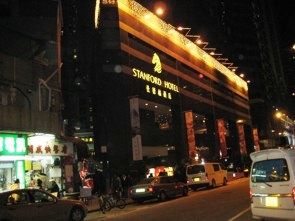
Night lights on Soy Street
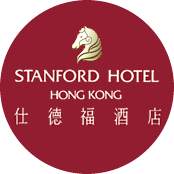

Stanford Hotel -
the exotic window arrangement gives everyone some interesting
views.
 Hong Kong Railway Museum, Tai Po, New
Territories
- 2009
Hong Kong Railway Museum, Tai Po, New
Territories
- 2009
This is a small but immaculate collection of KCR equipment, and the
original Tai Po station built in 1913 on the Kowloon Canton
Railway. An older diesel, a narrow gauge steam engine, and 6
passenger cars are on display, with numerous artifacts in the
station. An LGB model train runs
in the garden at the push of a button.
 The
diesel-electric locomotive #51 was introduced in
1955. This one is named "Sir Alexander", after the former
Governor Alexander Grantham.
The
diesel-electric locomotive #51 was introduced in
1955. This one is named "Sir Alexander", after the former
Governor Alexander Grantham.
An early W.G. Bagnall 0-4-4T narrow gauge
steam locomotive, restored from the Philippines in 1995, is one
of two that formerly ran on the Sha Tau Kok Railway
line between Fanling and Sha Tau Kok. When that closed, they
were used by sugar mills in the Philippines. The other
locomotive of the pair was also brought back to Hong Kong and is
reported to be undergoing restoration. According to one
reference, these locos were probably used during construction of
the original KCR, which was narrow gauge while being built and
re-gauged before the railway opened.
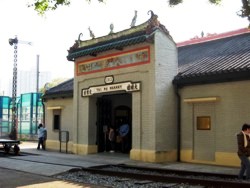 The six coaches
are:
The six coaches
are:
1911 third-class compartment #302
1921 engineering coach #002
1955 third-class compartment #223
1955 luggage compartment #229
1964 first-class compartment #112
1976 ordinary-class compartment #276
In addition, these, there are a hand-car and a diesel-engined railcar.
The museum is located about half way between
Tai Wo and Tai Po Market Stations on the MTR East Line (surface
railway). Catch the train at Mong Kok East and walk west on the
north side of the tracks from Tai Po Market Station. No entry
fee.
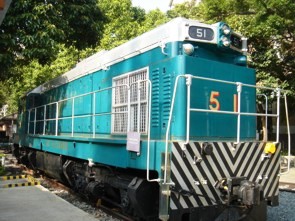
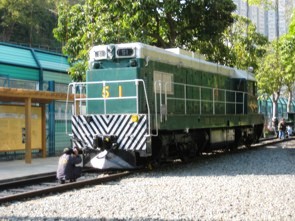
GE-EMD G-12 KCR #51 "Sir Alexander"
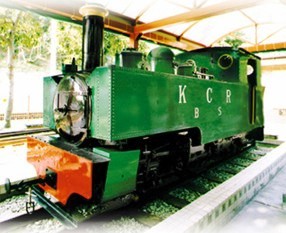
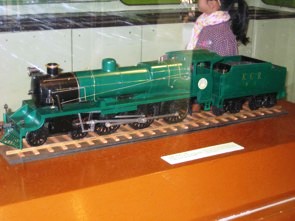
W. G. Bagnalls 0-4-4T Narrow
Gauge
Model on display

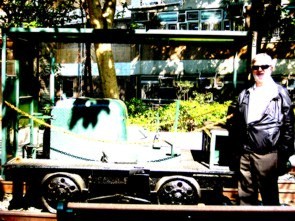
Ticket Display
Crew Car
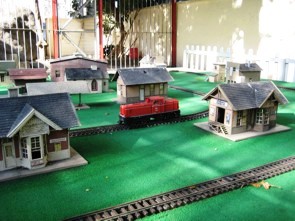
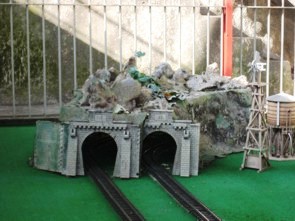
G Gauge Garden Railway at Tai Po Railway Museum
Wikipedia Page
 Victoria Peak Tram, Hong Kong Island
Victoria Peak Tram, Hong Kong Island
 The Peak Tram dates back to 1888 when it used a coal fired
boiler to run a steam driven cable to operate two funicular
cars. The upbound car is balanced by the downbound car, thus
little real power is needed. It runs on a single track with a
passing siding at the halfway point. Today it is electric and
the two two-car trains carry 120 passengers each way.
The Peak Tram dates back to 1888 when it used a coal fired
boiler to run a steam driven cable to operate two funicular
cars. The upbound car is balanced by the downbound car, thus
little real power is needed. It runs on a single track with a
passing siding at the halfway point. Today it is electric and
the two two-car trains carry 120 passengers each way.
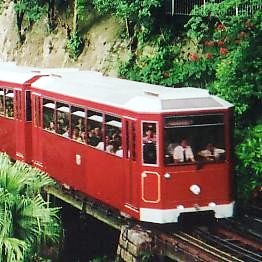
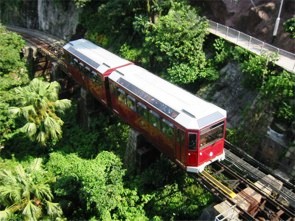
The
current 2-car trams were built in 1989 by Gangloff in Switzerland.
The track is 1384 meters long and rises 368 meters with a
maximum grade of 27 degrees. Track gauge is 4 ft 11-7/8 inches
(1520 mm).
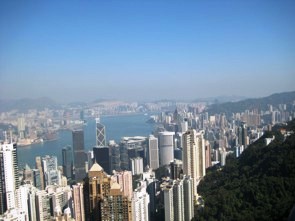
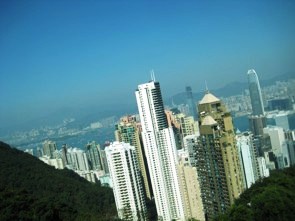
Views from Victoria Peak: Kowloon
Hong Kong
The upper station is all glass and steel now, with six stories of
shops and lookouts reached by a dozen escalators. Nothing like
1974; this was a parking lot for tourists then. You will find
the lower Peak Tram Station a short walk south of the MTR
Central Station. Cash fare only.
Historical Photos from Peak Tram Website
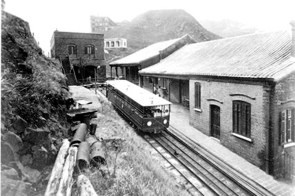
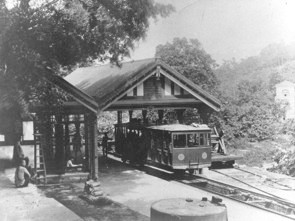
1888
1890
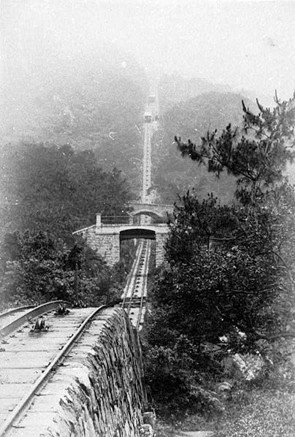
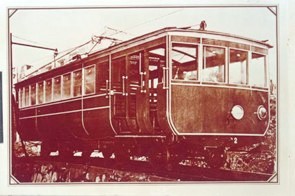
1897
1926
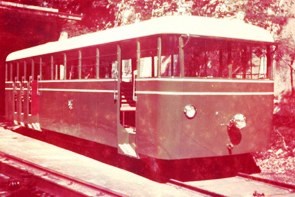
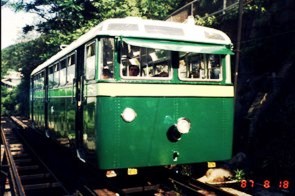
1948
1970
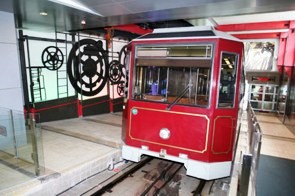
1998
 Streetcars, Hong Kong Island
- 2009
Streetcars, Hong Kong Island
- 2009
 Streetcars
and high speed mass transit co-exist in Hong Kong, as they do in
Toronto, Munich, and other intelligently planned cities. In
fact, a proposal to replace the streetcars in Hong Kong with
another subway was voted down by the citizens. Surface stops,
frequent service, low priced fares, and no stairs won the day.
Streetcars
and high speed mass transit co-exist in Hong Kong, as they do in
Toronto, Munich, and other intelligently planned cities. In
fact, a proposal to replace the streetcars in Hong Kong with
another subway was voted down by the citizens. Surface stops,
frequent service, low priced fares, and no stairs won the day.
Hong Kong Tramways dates back to 1904 and the cars look much the
same today as they did then, as well as in 1974 during my first
visit. As double deckers, they look top heavy and ride pretty
roughly, especially around sharp corners. There were no real
skyscrapers in 1974, but lots now.
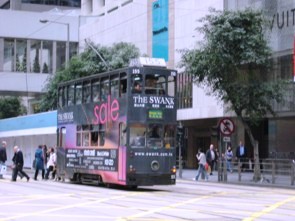 The streetcar makes a long 13 km east west run through downtown
Hong Kong and returns on double track. A complete round trip on
the Kennedy Town - Shau Kei Wan route will take 2 hours 20
minutes, so it's a great way to see the new and the old
close-up. There are 163 cars available for service, running six
different variations of the downtown route. All were built and
refurbished by the railway shops.
The streetcar makes a long 13 km east west run through downtown
Hong Kong and returns on double track. A complete round trip on
the Kennedy Town - Shau Kei Wan route will take 2 hours 20
minutes, so it's a great way to see the new and the old
close-up. There are 163 cars available for service, running six
different variations of the downtown route. All were built and
refurbished by the railway shops.
We rode car #155 for quite a
while. 
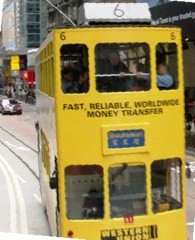
 Car #6 trailed behind
Car #6 trailed behind
Many tramcars date back to the 1930's, with many modernizations
and improvements across the years. Newer cars were built in the
1950's and 60's, and 3 were built in 2000 with air conditioning.
Two older cars (#28 and #128) were refurbished to look like the
original 1912 versions for tourists and private parties.
The cars can hit 50 Km/hour, run on 550 volts DC, and travel on
1067 mm (42 inch) gauge track. Cars are rated at 115 passengers
and run 1.5 minutes apart in rush hour while competing for space
amongst auto and pedestrian traffic.

Use MTR to Central or Admiralty Stations or the Kowloon Ferry;
both drop you within a block of the tracks. Cash fare or
Octopus card as you alight.
Historical Photos from Tramways Website
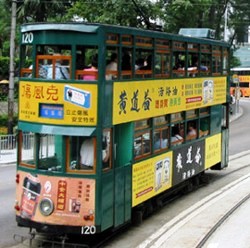
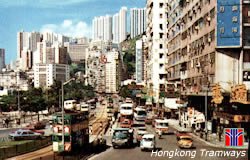
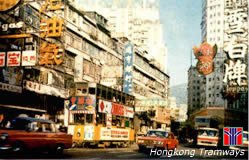
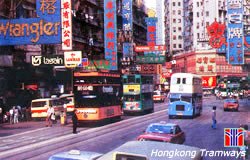
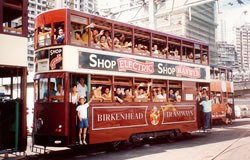
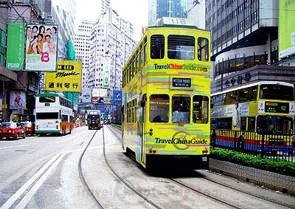
28
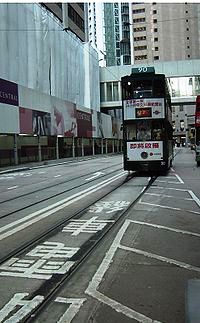 90
90
120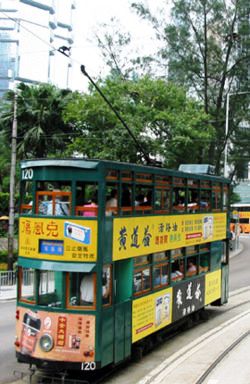
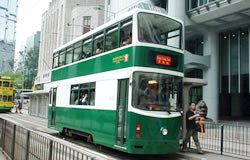 169
169
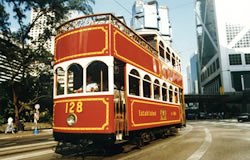 128
128
Wikipedia Page
 Hong Kong Mass Transit Railway (MTR)
- 2009
Hong Kong Mass Transit Railway (MTR)
- 2009
 In 1974, MTR was just a dream about
to change Hong Kong forever.
The first line was opened in 1979, with many mote to follow. The
system now carries four million passengers every weekday on very modern 7, 8
or 12 car trains (depending on the route) - fast, smooth, quiet, frequent, cheap, and
on-time. There are 211 Km of track with 150 stations. There are
10 subway routes and 11 surface routes.
In 1974, MTR was just a dream about
to change Hong Kong forever.
The first line was opened in 1979, with many mote to follow. The
system now carries four million passengers every weekday on very modern 7, 8
or 12 car trains (depending on the route) - fast, smooth, quiet, frequent, cheap, and
on-time. There are 211 Km of track with 150 stations. There are
10 subway routes and 11 surface routes.
 Station announcements are in Cantonese, Mandarin, and English,
plus illuminated route maps over the doors, making it easy to
get off at the right stop. The many routes seem complicated at
first so a good map is essential at all times. Stations are huge
with many exits. There are at least three flights of stairs and
probably one or two escalator rides to get to your train.
Turnstiles, not to mention the stairs, make large luggage a bad
idea.
Station announcements are in Cantonese, Mandarin, and English,
plus illuminated route maps over the doors, making it easy to
get off at the right stop. The many routes seem complicated at
first so a good map is essential at all times. Stations are huge
with many exits. There are at least three flights of stairs and
probably one or two escalator rides to get to your train.
Turnstiles, not to mention the stairs, make large luggage a bad
idea.
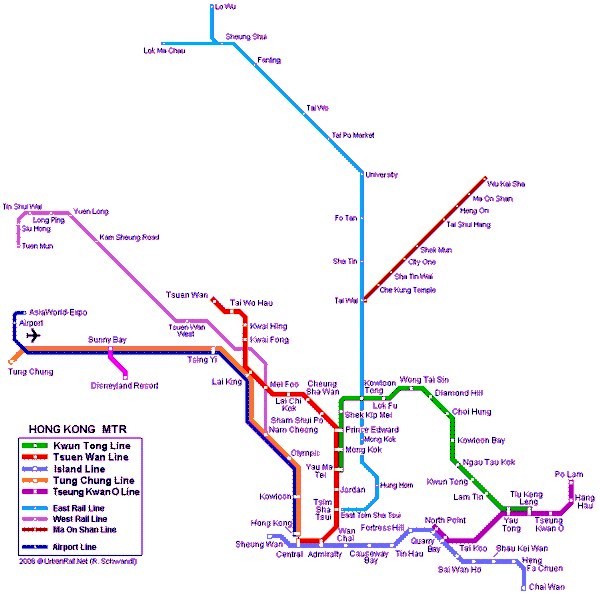
Click HERE for larger map
Click HERE for expanded view
of downtown map
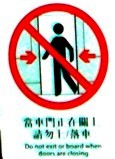 Although there is a human driver, the trains are basically
computer controlled to stop within inches of the correct
position. Most station platforms have glass walls to prevent
people from accidentally falling on the tracks, so the train
must stop precisely at the automatic sliding doors in the
protective screens. Most cars can hold up to 300 passengers, and at rush
hour, probably more. The trains can hit 80 Km/hour between
stations with very smooth acceleration and braking systems. A
few lines have a first class car in the middle of the
train; for double fare, you get a padded seat and leg room.
Although there is a human driver, the trains are basically
computer controlled to stop within inches of the correct
position. Most station platforms have glass walls to prevent
people from accidentally falling on the tracks, so the train
must stop precisely at the automatic sliding doors in the
protective screens. Most cars can hold up to 300 passengers, and at rush
hour, probably more. The trains can hit 80 Km/hour between
stations with very smooth acceleration and braking systems. A
few lines have a first class car in the middle of the
train; for double fare, you get a padded seat and leg room.
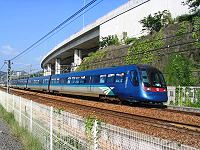
Airport Express on Cross Harbour Bridge, taken
from Ngong Ping
360 Gondola 
The airport line is less crowded and very first class, arriving
at Central and Kowloon Stations in less than 25 minutes. Get
your Octopus card as you leave the airport - it gives a return
trip to the airport plus 3 free days travel on the rest of the
MTR for a reasonable fee. You can add more money to the card at
any MTR station
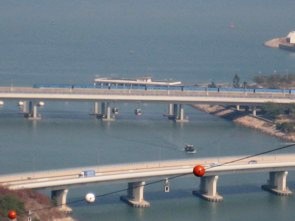
 .
.
All subway and surface lines are electric, standard gauge (4 ft
8-1/2 inches, 1435 mm) but diesel powered inter-city express
trains also use the surface lines. These diesels have a gorgeous
burbling exhaust, well muffled for urban environments.
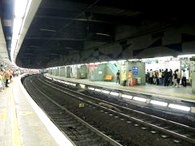
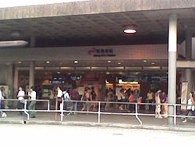
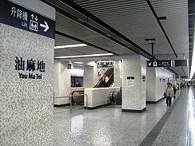
Mong Kok Station inside and out
Yau Ma Tei Station inside

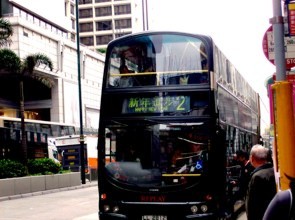
Train at Yau Ma Tei
Local bus on Nathan Road
The MTR runs special dedicated trains to Disneyland from Sunny
Bay Station. The windows are shaped as a profile of Mickey
Mouse. There must be a word for something that is too cute for
words. The station is also pure Disney.


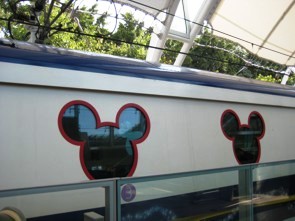
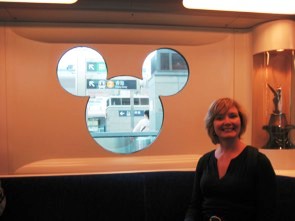
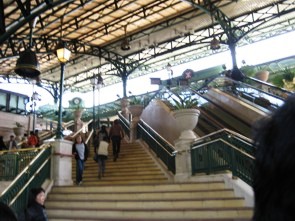
 Bus
LINes, Hong Kong Island and Kowloon
Bus
LINes, Hong Kong Island and Kowloon
The buses are all relatively new rear-engined double decker jobs
from various makers. All the old front-engined "snout-nosed"
buses I saw on my first trip are gone. Like the streetcars, the
new buses seem top heavy but sway on corners is amazingly
slight, although the ride can be rough. Pollution and noise
suppression are excellent - no smoke or smell.
The upstairs views are pretty good if you don't get sea-sick
from all the motion. The buses have great acceleration and
brakes, so hang on tight. A good ride is from Central to Stanley
or Aberdeen on Hong Kong Island. If you want scary, try the trip
from Victoria Peak back to Central.
There are five privately owned bus companies serving the Hong
Kong area with large buses on fixed routes, plus MTR which runs
feeder buses to train stations. Publicly owned mini
buses cover more local and feeder routes. Cash fare or
prepaid Octopus card work on all.
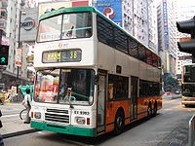
 Leyland Titans c.1974
Leyland Titans c.1974

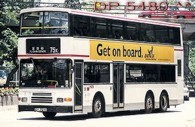
Modern rear engine buses 2009
Things you can't do on a bus
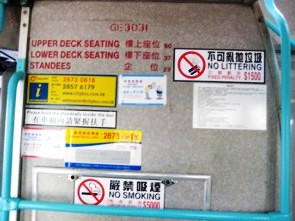
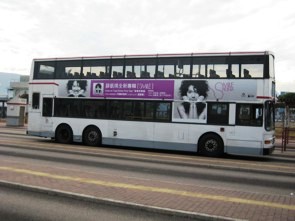
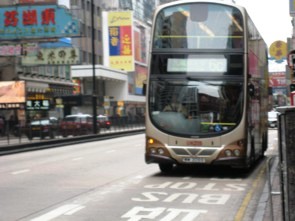
At Wampoa Mall
On Nathan Road
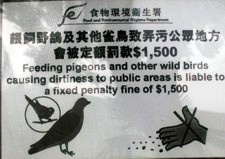
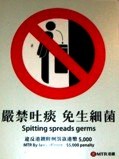
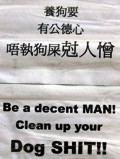

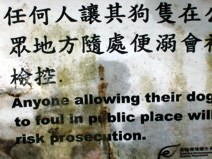

More suggestions you probably should observe in Hong Kong
 Hong Kong - Kowloon
FerrY - 2009
Hong Kong - Kowloon
FerrY - 2009
 The Star ferries carry passengers across the Victoria Harbour,
between Hong Kong Island and Kowloon. beginning in 1888. The
fleet of twelve ferries operates four routes across the harbour,
carrying over 70,000 passengers a day. All are diesel
electric, built between 1956 and 1998.
The Star ferries carry passengers across the Victoria Harbour,
between Hong Kong Island and Kowloon. beginning in 1888. The
fleet of twelve ferries operates four routes across the harbour,
carrying over 70,000 passengers a day. All are diesel
electric, built between 1956 and 1998.
Even though there
are now other ways to cross the harbour (by MTR and road
tunnels), the Star Ferry continues to provide an efficient,
popular, and inexpensive crossing of the harbour.
The main route
runs between Central and Tsim Sha Tsui, opposite the Peninsula
Hotel, where I stayed in 1974. Only millionaires can afford to
stay there now. The original Edinborough
pier and clock tower I remember from my 1974 trip were torn down
and replaced in 2006, sans clock. The other routes are Wan Chai
to Tsim Sha Tsui, Central to Hung Hom,
and Wan Chai to Hung Hom. A Harbour Tour makes an indirect,
circular route to all the stops, namely Tsim Sha Tsui, Central,
Wan Chai, and Hung Hom.
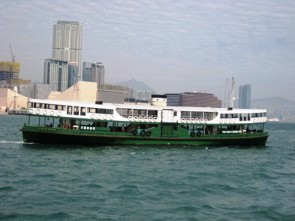

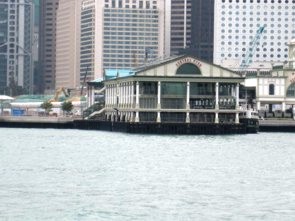
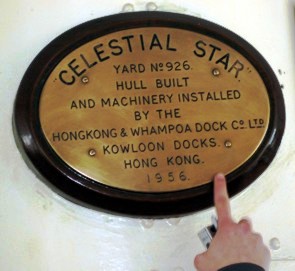
Ferry scenes on Victoria Harbour, Celestial is the
oldest, built in 1956.
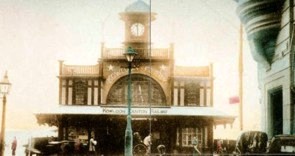
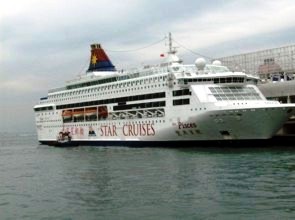
Kowloon Ferry
Terminal c.1974
Star Cruise Ship
 Hong
Kong - Macau FerrY - 2009
Hong
Kong - Macau FerrY - 2009
 Several fleets of high-speed Macau ferry
vessels serve the 40-mile route between
Hong Kong and Macau: jetfoils,
turbo-cats, jumbo-cats and CotaiJet.
There are more than 100 sailings
throughout the day and evening, with
all-night service by jetfoils.
Several fleets of high-speed Macau ferry
vessels serve the 40-mile route between
Hong Kong and Macau: jetfoils,
turbo-cats, jumbo-cats and CotaiJet.
There are more than 100 sailings
throughout the day and evening, with
all-night service by jetfoils.
There are two terminals in
Hong Kong. The main sea
terminal and heliport are
located in Shun Tak Centre,
on the waterfront west of
Central District on Hong
Kong Island. It stands over
the MTR Sheung Wan Station.
The other terminal is the
China Ferry Terminal offering ferry
services from the Kowloon
side, located on the Tshim Sha Tsui waterfront
alongside Harbour City, and
is used for Jumbocats, and
Hover-ferry sailing to and
from Macau.
In Macau, the Maritime
Terminal and heliport is
situated in the Outer
Harbour, close to lots of
casinos and hotels. The
older, more interesting
city, is a modest hike west
and inland a bit. Good restaurants exist but are
hard to find.
The Boeing 929 - 100 Jetfoil hydrofoil ferries are
90 feet long with a beam of 31 feet carrying 190
passengers in very comfortable seats. They can
travel 50 miles per hour using two 3300 horsepower
gas turbines driving 2 mixed
axial flow, 24,000 gallons/minute
Rockwell Rocketdyne Powerjet 20's. The ship burns
430 US gallons of fuel per hour, getting about 0.1
miles per gallon. The hydrofoils lift the ship's
hull out of the water giving a very smooth ride even
in a large swell.
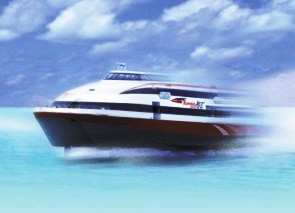
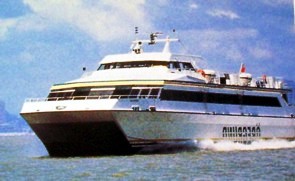
The oldest Jetfoil "Flores"
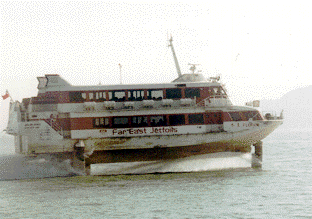 built in 1975.
built in 1975.
A year before our trip to Hong Kong
and Macau, 133 of 435 passengers
were injured, 19 of them seriously,
when two high-speed ferries, Funchal
and Santa Maria, collided five
nautical miles away from Macau and
limped back to Macau to treat the
injured. Now I know why some, but
not all, Jetfoil ships have
seatbelts. But where in hell was the
radar that night????
 Ngong Ping 360 Cable Cars to Giant Buddha
Ngong Ping 360 Cable Cars to Giant Buddha
Ngong Ping 360, sometimes called Skyrail, travels about 5.7 Km
on a dual cable system over 8 towers (counting the two terminal
towers), rising 428 meters on Lantau Island. One cable hauls the
cars, the other acts as the support rail. Each of 109 cabins
carry up to 17 passengers on the 25 minute ride, giving a
capacity of 3500 passengers per hour each way.
The contractor and initial operator was Skyrail-ITM of
Australia, using equipment built by Leitner of Austria, and is
owned and now operated by MTR. It was completed in 2006, but
closed for 6 months in 2007 when an empty cabin fell 50 meters
in an after hours accident during a system brake test. Skyrail-ITM was fired after the accident and MTR took over the
cableway.
Mules from Canada were used to carry equipment and supplies
through sensitive environmental areas so no new roads needed to be
built. No one assessed the environmental impact of all that mule
poop. Large items were brought in by helicopter.
The cableway starts near the MTR Tung Chung Station and
terminates near the Giant Buddha at Ngong Ping, a theme village
especially built to exploit tourists. There are no intermediate
stops. Cash fare or prepaid Octopus card.
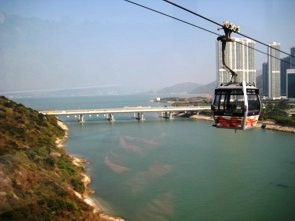
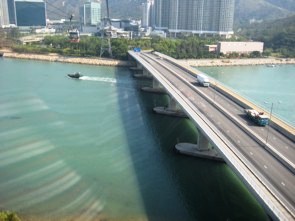
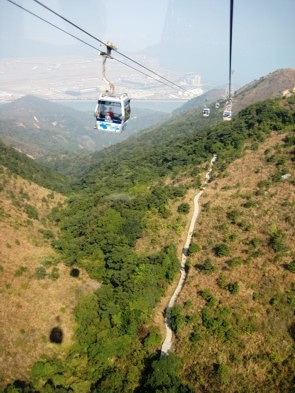

Views from the Ngong Ping 360 Cable Car
![]() Hong
Kong - Macau FerrY - 2009
Hong
Kong - Macau FerrY - 2009![]() Several fleets of high-speed Macau ferry
vessels serve the 40-mile route between
Hong Kong and Macau: jetfoils,
turbo-cats, jumbo-cats and CotaiJet.
There are more than 100 sailings
throughout the day and evening, with
all-night service by jetfoils.
Several fleets of high-speed Macau ferry
vessels serve the 40-mile route between
Hong Kong and Macau: jetfoils,
turbo-cats, jumbo-cats and CotaiJet.
There are more than 100 sailings
throughout the day and evening, with
all-night service by jetfoils.

 built in 1975.
built in 1975. 
 The
island country of Fiji in the South Pacific Ocean creates memories of tropical Paradise that
last a lifetime. In addition, Fiji has trains - not many and not
fancy, but easily found by tourists. One is shown here from a
vacation in 1993. The Sugar
Cane Train operated by Coral Coast Railway runs from Sigatoka up to Natadola Beach. Nearest airport is Nadi, Fiji,
about an hour north of Sigatoka.
The
island country of Fiji in the South Pacific Ocean creates memories of tropical Paradise that
last a lifetime. In addition, Fiji has trains - not many and not
fancy, but easily found by tourists. One is shown here from a
vacation in 1993. The Sugar
Cane Train operated by Coral Coast Railway runs from Sigatoka up to Natadola Beach. Nearest airport is Nadi, Fiji,
about an hour north of Sigatoka. 










 Coral Coast Railway
Coral Coast Railway Australia hosts many narrow gauge tourist trains, as
well as some mainlines that were never converted to standard
gauge. At one time there were thousands of miles of 42" gauge
railways in Australia. One of these is shown here from a
vacation in 1993.
The Kuranda Scenic Railway runs from
Cairns (Queensland) north to Kuranda and return, about 34 kilometers
each way. Tracks are three-foot six-inch gauge on immaculate
mainline right-of-way.
Australia hosts many narrow gauge tourist trains, as
well as some mainlines that were never converted to standard
gauge. At one time there were thousands of miles of 42" gauge
railways in Australia. One of these is shown here from a
vacation in 1993.
The Kuranda Scenic Railway runs from
Cairns (Queensland) north to Kuranda and return, about 34 kilometers
each way. Tracks are three-foot six-inch gauge on immaculate
mainline right-of-way.


 The
line was begun in 1882 by Christie Palmerston and completed in June
1891, to serve miners in the area. Dense jungle and cliffs with
sheer drops of up to 327 metres and a slope as steep as 45 degrees
were literal death traps for workers. Without modern equipment but
simply fortitude, dynamite, and bare hands the team eventually
finished the job, after removing 2.3 million cubic meters of
earthwork, creating 15 tunnels, 93 curves, dozens of bridges, and 75
kilometres of track.
The
line was begun in 1882 by Christie Palmerston and completed in June
1891, to serve miners in the area. Dense jungle and cliffs with
sheer drops of up to 327 metres and a slope as steep as 45 degrees
were literal death traps for workers. Without modern equipment but
simply fortitude, dynamite, and bare hands the team eventually
finished the job, after removing 2.3 million cubic meters of
earthwork, creating 15 tunnels, 93 curves, dozens of bridges, and 75
kilometres of track. 










 The 1974 train trip from Kowloon to Canton (now Guangzhou) ran
22
miles north to the Chinese border at Lo Wu. Here we walked across a bridge,
through customs, to catch the steam driven express for the
remaining 89 miles to Canton, followed by the longer trip to Shanghai.
The 1974 train trip from Kowloon to Canton (now Guangzhou) ran
22
miles north to the Chinese border at Lo Wu. Here we walked across a bridge,
through customs, to catch the steam driven express for the
remaining 89 miles to Canton, followed by the longer trip to Shanghai.




 In
1974, there were official "minders" at every transfer point to
see that we found the correct train and did not stray into
sensitive areas. We were the only North Americans on the train,
the balance were Chinese officials, plus British, German, and
French businessmen. Miles of rice paddies, water buffalo,
farmers up to their knees in water, small villages, and many
bridges whizzed past as we rumbled along to Shanghai. We were
not allowed to take pictures from the train. The steam
locomotive at right is similar to the one that hauled us from
Canton to Shanghai.
In
1974, there were official "minders" at every transfer point to
see that we found the correct train and did not stray into
sensitive areas. We were the only North Americans on the train,
the balance were Chinese officials, plus British, German, and
French businessmen. Miles of rice paddies, water buffalo,
farmers up to their knees in water, small villages, and many
bridges whizzed past as we rumbled along to Shanghai. We were
not allowed to take pictures from the train. The steam
locomotive at right is similar to the one that hauled us from
Canton to Shanghai. Aside from the 1974 and 2009 trips into Hong Kong, I passed
through the old Kai Tak airport on at least 5 other trips before
it was closed in 1998, en route to Bangladesh or Indonesia.
Aside from the 1974 and 2009 trips into Hong Kong, I passed
through the old Kai Tak airport on at least 5 other trips before
it was closed in 1998, en route to Bangladesh or Indonesia.  The inter-city trains to
Guangzhou and beyond use the same track as the East Line, running diesel powered
express trains, including some high speed bi-level tilt cars, as
well as a "bullet" train. There are at least 10 such trains per
day between Kowloon and Guangzhou.
The inter-city trains to
Guangzhou and beyond use the same track as the East Line, running diesel powered
express trains, including some high speed bi-level tilt cars, as
well as a "bullet" train. There are at least 10 such trains per
day between Kowloon and Guangzhou.

 The
diesel-electric locomotive #51 was introduced in
1955. This one is named "Sir Alexander", after the former
Governor Alexander Grantham.
The
diesel-electric locomotive #51 was introduced in
1955. This one is named "Sir Alexander", after the former
Governor Alexander Grantham. 

 The Peak Tram dates back to 1888 when it used a coal fired
boiler to run a steam driven cable to operate two funicular
cars. The upbound car is balanced by the downbound car, thus
little real power is needed. It runs on a single track with a
passing siding at the halfway point. Today it is electric and
the two two-car trains carry 120 passengers each way.
The Peak Tram dates back to 1888 when it used a coal fired
boiler to run a steam driven cable to operate two funicular
cars. The upbound car is balanced by the downbound car, thus
little real power is needed. It runs on a single track with a
passing siding at the halfway point. Today it is electric and
the two two-car trains carry 120 passengers each way. 








 Streetcars
and high speed mass transit co-exist in Hong Kong, as they do in
Toronto, Munich, and other intelligently planned cities. In
fact, a proposal to replace the streetcars in Hong Kong with
another subway was voted down by the citizens. Surface stops,
frequent service, low priced fares, and no stairs won the day.
Streetcars
and high speed mass transit co-exist in Hong Kong, as they do in
Toronto, Munich, and other intelligently planned cities. In
fact, a proposal to replace the streetcars in Hong Kong with
another subway was voted down by the citizens. Surface stops,
frequent service, low priced fares, and no stairs won the day.







 90
90
 169
169 128
128
 Although there is a human driver, the trains are basically
computer controlled to stop within inches of the correct
position. Most station platforms have glass walls to prevent
people from accidentally falling on the tracks, so the train
must stop precisely at the automatic sliding doors in the
protective screens. Most cars can hold up to 300 passengers, and at rush
hour, probably more. The trains can hit 80 Km/hour between
stations with very smooth acceleration and braking systems. A
few lines have a first class car in the middle of the
train; for double fare, you get a padded seat and leg room.
Although there is a human driver, the trains are basically
computer controlled to stop within inches of the correct
position. Most station platforms have glass walls to prevent
people from accidentally falling on the tracks, so the train
must stop precisely at the automatic sliding doors in the
protective screens. Most cars can hold up to 300 passengers, and at rush
hour, probably more. The trains can hit 80 Km/hour between
stations with very smooth acceleration and braking systems. A
few lines have a first class car in the middle of the
train; for double fare, you get a padded seat and leg room.
 .
.



 Leyland Titans c.1974
Leyland Titans c.1974 

 The Star ferries carry passengers across the Victoria Harbour,
between Hong Kong Island and Kowloon. beginning in 1888. The
fleet of twelve ferries operates four routes across the harbour,
carrying over 70,000 passengers a day. All are diesel
electric, built between 1956 and 1998.
The Star ferries carry passengers across the Victoria Harbour,
between Hong Kong Island and Kowloon. beginning in 1888. The
fleet of twelve ferries operates four routes across the harbour,
carrying over 70,000 passengers a day. All are diesel
electric, built between 1956 and 1998. 

